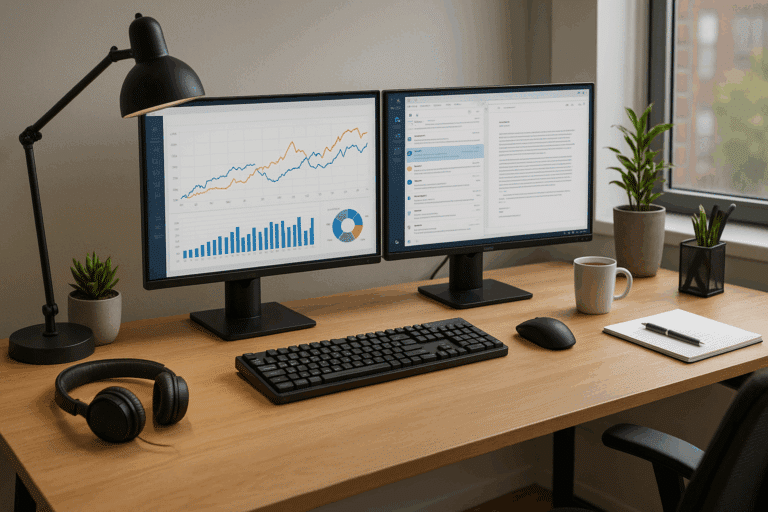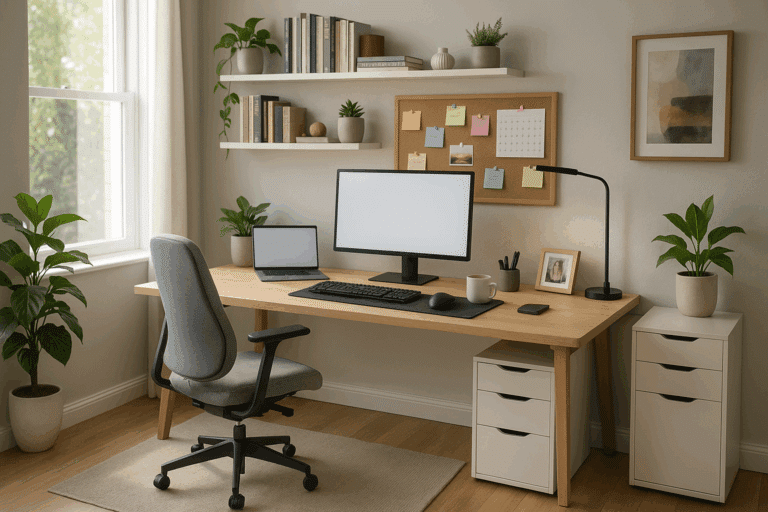The modern workspace is no longer just a place to simply carry out our daily tasks. It is an environment that can inspire creativity, boost productivity, and even contribute to our overall well-being. Understanding this, more and more businesses are investing in creating office spaces that not only meet their functional needs but also provide a pleasant and motivating environment for their teams. But what if you’re on a tight budget? Can you still transform your workspace into a place that sparks joy and productivity? The answer is a resounding YES! 💪
With a little creativity and smart planning, it is entirely possible to revamp your workspace without breaking the bank. This blog post will provide you with a slew of budget-friendly makeover ideas that can help you transform your office into a place you and your team will love. 🛠️
Why You Should Consider a Workspace Makeover
Before we dive into the affordable makeover ideas, let’s briefly discuss why a workspace makeover is a worthy investment. A well-designed workspace can do more than just enhance aesthetic appeal. It can impact employees’ mood, productivity, and even health. A cluttered, uninspiring workspace can lead to stress and low morale, whereas an organized, visually pleasing environment can stimulate creativity and foster a positive work culture. And let’s not forget that the right workspace design can also leave a good impression on your clients. So, while you might be apprehensive about the cost, keep in mind that a workspace makeover can actually be an investment with a high return.
Setting the Stage for Your Workspace Transformation
Before embarking on your budget-friendly office makeover journey, it is crucial to have a clear vision of what you want to achieve. Begin by assessing your current workspace. Identify what works and what doesn’t. Look out for elements that could be hindering productivity or creating discomfort. Once you have a solid understanding of your workspace’s strengths and weaknesses, you can move forward with a strategic plan that addresses your specific needs and budget constraints. Remember, the goal is to create a workspace that not only looks good but also enhances functionality and productivity. 🎯
Coming up: Budget-Friendly Makeover Ideas
In the forthcoming sections of this article, we will explore various affordable makeover ideas that you can implement in your office. We will discuss everything from optimizing space and improving lighting to incorporating plants and artwork. Each idea will be presented in a detailed, easy-to-understand manner, providing you with all the information you need to get started on your workspace transformation. So whether you’re a startup on a shoestring budget or a small business looking to cut costs, you’ll find solutions that are not only affordable but also easy to implement.
To conclude this introduction, let me emphasize that transforming your workspace doesn’t have to be a costly venture. With the right approach and a bit of creativity, you can create a workspace that reflects your brand, fosters productivity, and provides a pleasant environment for everyone. So get ready to roll up your sleeves and breathe new life into your office space! 🔨🔧
Discover Affordable Workspace Transformation Ideas
Our work environment significantly impacts our productivity, creativity, and overall job satisfaction. However, many people perceive office revamping as an expensive venture, which isn’t necessarily the case. It’s entirely possible to rejuvenate your workspace on a budget. If you’re wondering how, this article will guide you through some practical and affordable workspace transformation ideas that can completely change the ambience of your office.
But before we dive into the details, let’s discuss the importance of a conducive work environment. A well-designed workspace can boost your mood, make you more comfortable, and ultimately enhance your productivity. But the big question is – how can you create such a workspace without breaking the bank? The answer lies in smart planning, creative ideas, and strategic implementation.
Whether you’re an entrepreneur looking for ways to revamp your start-up office or a professional hoping to give your home office a makeover, the following tips and ideas will be useful. Grab a cup of coffee, and let’s start transforming your workspace!
Set the Stage with Strategic Planning
The first step in achieving a budget-friendly office makeover is strategic planning. Consider factors such as your budget, the available space, and your specific needs. What elements would you like to incorporate into your workspace? What are your must-haves and nice-to-haves? It’s crucial to strike a balance between aesthetics and functionality.
Start by creating a list of all the items you need, categorize them into essentials and non-essentials, and prioritize based on your budget. Here is an example of how you can structure your list:
| Essential Items | Non-essential Items |
|---|---|
| Comfortable desk and chair | Artworks and decorations |
| Effective lighting | Extra monitor |
| Powerful computer | High-end speakers |
By setting a budget and sticking to it, you can avoid unnecessary expenses and ensure a cost-effective transformation of your workspace.
Revitalize Your Workspace with DIY Projects
DIY projects are a fantastic way to revamp your workspace on a budget. Not only can they save you money, but they also provide an opportunity to customize your office to your liking. You can create your own desk, shelves, or even a unique office lamp. There’s a vast array of DIY tutorials available online, and many of them don’t require any prior experience or specialized tools. A great starting point is “10 DIY Desk Ideas for Home Offices” by DIY Creators on YouTube.
The great thing about DIY projects is that you can use materials you already have, like old wooden pallets or unused paint, further saving costs. Plus, there’s a certain satisfaction in creating something with your own hands and watching it transform your workspace.
And it’s not just about furniture. You can also DIY your office decor. For instance, you can create your own wall art, or even a corkboard for important reminders. Just remember, the goal here is to make your workspace more functional and appealing, so choose projects that align with that objective.
Optimize Your Space with Clever Storage Solutions
No matter how big or small your workspace is, storage can be a major challenge. However, with a little creativity, you can turn this challenge into an opportunity. The key here is to optimize every inch of your workspace. Think vertical and use your walls for storage. Install floating shelves or hang a pegboard to keep your workspace organized and clutter-free. Check out the video “5 EASY DIY Desk Organization Ideas” by Alexandra Gater for inspiration.
Also, consider dual-purpose furniture that can serve as storage. For example, a desk with built-in drawers or a chair with storage space underneath can be an excellent space-saving solution. And remember, an organized workspace is not only visually appealing but also promotes efficiency and productivity.
Remember, the aim is to create a workspace that sparks joy and boosts your productivity. So don’t be afraid to think outside the box and experiment with different ideas. And most importantly, have fun with the process!
Don’t Forget to Inject Your Personality
Finally, one of the most affordable ways to revamp your workspace is by infusing it with your personality. You spend a considerable amount of time in your workspace, so it should reflect your tastes and preferences. Incorporate items that make you happy and inspire you. This could be anything from your favorite artwork, inspirational quotes, or even a small indoor plant. For ideas on how to personalize your workspace, watch the video “How To Make Your Workspace Personal & Inspiring” by The Sorry Girls.
Remember, you don’t have to do everything at once. You can start small and gradually add elements that reflect your personality. Not only will this approach save you money, but it will also allow you to continually enhance your workspace over time.
Revamping your workspace doesn’t have to be expensive. With a little creativity, strategic planning, and DIY spirit, you can transform your office into a space that is both functional and aesthetically pleasing, without burning a hole in your pocket. So, what are you waiting for? Start planning your workspace transformation today!

Conclusion
In wrapping up this detailed discussion on the intricacies of Software Engineering, we have traversed a wide array of topics. We began by outlining the essence of software engineering, drawing particular emphasis on the systematic approach it uses to understand, design, and manage software systems. 🖥️
We delved into the essential roles that software engineers play, from defining system requirements, to designing and implementing solutions, to testing and maintaining the systems they build. We also highlighted the integral knowledge base and skill set required in this field, which spans mathematics, computer science, and project management. This, we hope, provided a vivid picture of the vast landscape of software engineering.
As we progressed, we painted a picture of the software development lifecycle, highlighting its stages from planning, analysis, design, and coding, through to testing and maintenance. Our discussion on each stage helped to underscore the complex and iterative nature of software development, and the critical role of software engineers in navigating these processes successfully.
We also explored some of the key methodologies used in software engineering, including Waterfall, Agile, and DevOps. These methodologies, each with its unique strengths and weaknesses, provide different lenses through which software engineers can approach and manage projects. 📈
In discussing the future of software engineering, we underscored the growing influence of AI, IoT, and cloud computing. These emerging trends, we noted, are transforming the landscape of software engineering, demanding new skills and approaches from professionals in the field.
Looking back, it’s clear that software engineering is a dynamic and complex field, with a broad scope that touches almost every aspect of our lives. This, we believe, highlights the importance and relevance of this discussion.
We invite you to delve deeper into this fascinating field. To continue exploring, you can find more in-depth resources on software engineering at the [IEEE Software Engineering Society](https://www.computer.org/technical-committees/software-engineering/), the [Association for Computing Machinery](https://www.acm.org/), and the [Institute for Systems and Technologies of Information, Control and Communication](http://www.insticc.org/).
We encourage you to share this article with your peers, join in the conversation, and apply the insights gained here in your work. Feel free to leave comments, ask questions, or share your experiences in the field of software engineering.
We hope that this article has not only enlightened you on the technical aspects of software engineering but also inspired you to further explore and contribute to this evolving field.
In the world of software engineering, every day presents a new challenge and a new opportunity to create solutions that make a difference. As we have seen, this is a field where technical knowledge meets creativity, where logic meets innovation, and where the human mind meets the power of technology. 🚀
Remember, the future of software engineering is not just about what we can dream of or imagine. It’s about what we are willing to learn, to build, and to achieve. So, let’s keep learning, keep building, and keep pushing the boundaries of what’s possible.
As we say in the world of software engineering, the only limit is your imagination. So, keep dreaming, keep innovating, and keep changing the world, one line of code at a time.
With that, we close our deep dive into software engineering. We hope you enjoyed the journey as much as we did. See you on the next one! 💻
References:
1. IEEE Software Engineering Society
2. Association for Computing Machinery
3. Institute for Systems and Technologies of Information, Control and Communication



